1994 PONTIAC BONNEVILLE ABS
[x] Cancel search: ABSPage 4 of 290
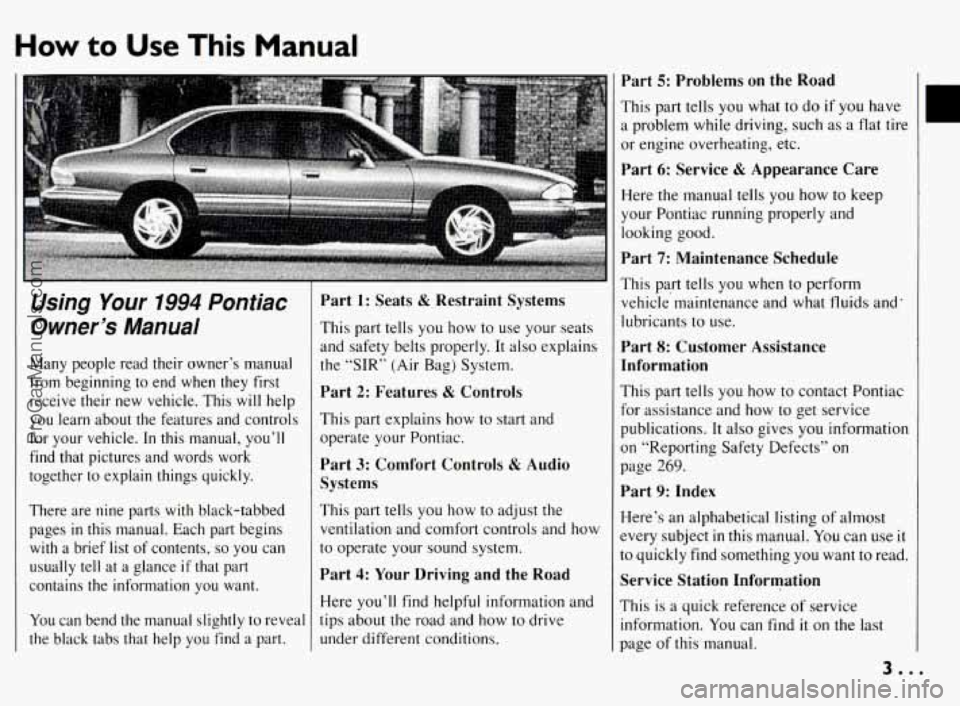
How to Use This Manual
Using Your 1994 Pontiac
Owner’s Manual
Many people read their owner’s manual
from beginning
to end when they first
receive their
new vehicle. This will help
you learn about the features and controls
for your vehicle. In this manual, you’ll
find that pictures and words work
together
to explain things quickly.
There are nine parts with black-tabbed pages
in this manual. Each part begins
with a brief list of contents,
so you can
usually tell at a glance
if that part
contains the information you want.
You can bend the manual slightly to reveal
the black tabs that help you find a part.
This part tells you how to use your seats
and safety belts properly. It also explains
the “SIR’ (Air Bag) System.
Part 2: Features & Controls
This part explains how to start and
operate your Pontiac.
Part 3: Comfort Controls & Audio
Systems
This part tells you how to adjust the
ventilation and comfort controls and how
to operate your sound system.
Part 4: Your Driving and the Road
Here you’ll find helpful information and
tips about the road and how
to drive
under different conditions.
Part 5: Problems on the Road
This part tells you what to do if you have
a problem while driving, such as a flat tire
or engine overheating, etc.
Part 6: Service & Appearance Care
Here the manual tells you how to keep
your Pontiac running properly and
looking good.
Part 7: Maintenance Schedule
This part tells you when to perform
vehicle’maintenance and what fluids and’
lubricants to use.
Part 8: Customer Assistance
Information
This part tells you how to contact Pontiac
for assistance and how
to get service
publications. It also gives
you information
on “Reporting Safety Defects”
on
page 269.
Part 9: Index
Here’s an alphabetical listing of almost
every subject
in this manual. You can use it
to quickly find something you want to read.
Service Station Information
This is a quick reference of service
information.
You can find it on the last
page of this manual.
3..
ProCarManuals.com
Page 85 of 290
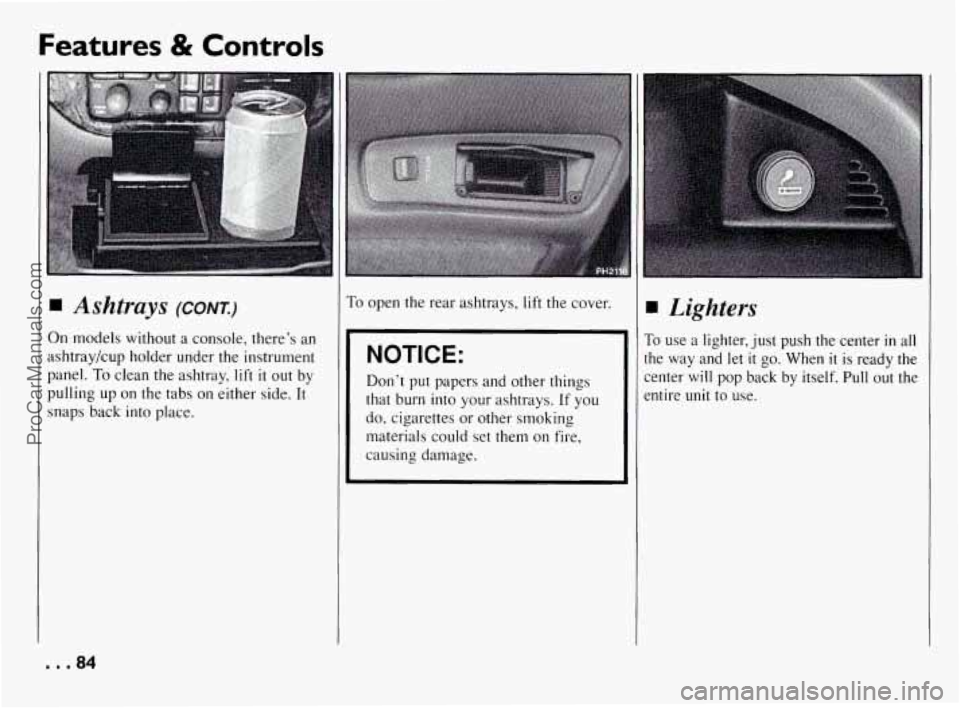
Features 8t Controls
Ashtrays (CONT.)
On models without a console, there’s an
ashtray/cup holder under the instrument
panel.
To clean the ashtray, lift it out by
pulling up on the tabs on either side.
It
snaps back into place.
... 84
To open the rear ashtrays, lift the cover.
NOTICE:
Don’t put papers and other things
that burn into your ashtrays.
If you
do, cigarettes or other smoking
inaterials could set them
on fire,
causing damage.
Lighters
To use a lighter, just push the center in all
the way and let
it go. When it is ready the
center
will pop back by itself. Pull out the
entire
unit to use.
ProCarManuals.com
Page 143 of 290
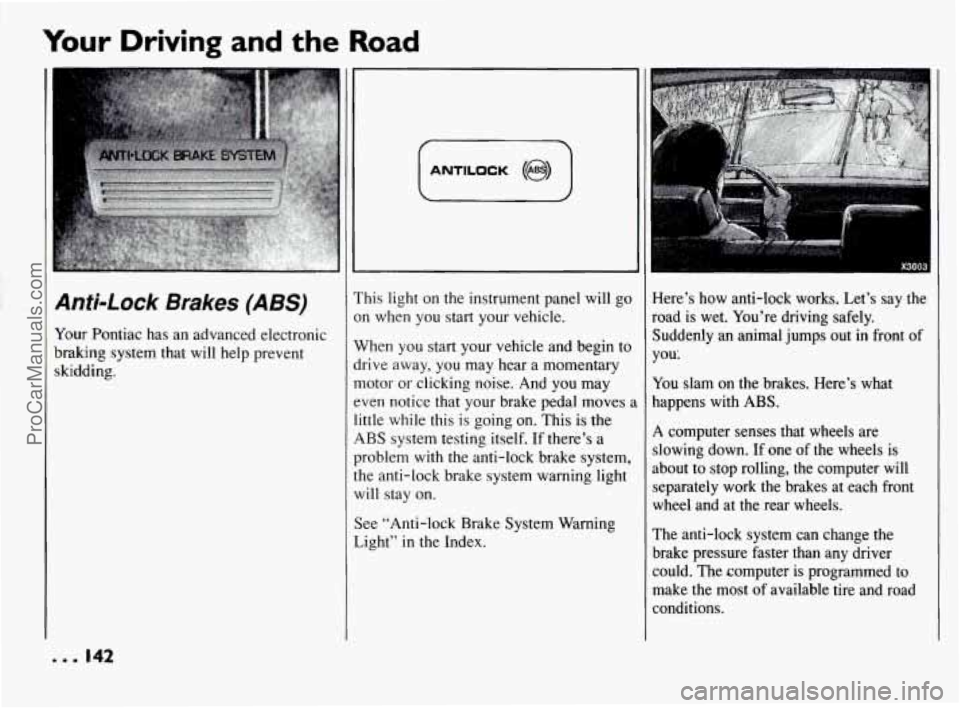
Your Driving and the Road
I
Anti-Lock Brakes (ABS)
Your Pontiac has an advanced electronic
braking system that will help prevent
skidding.
1 ANTILOCK @) 1
This light on the instrument panel will go
on when
you start your vehicle.
When you start your vehicle and begin to
drive away, you may hear a momentary
motor or clicking noise. And you may
even notice that your brake pedal moves
2
little while this is going on. This is the
ABS system testing itself. If there’s a
problem with the anti-lock brake system,
the anti-lock brake system warning light will stay on.
See “Anti-lock Brake System Warning
Light” in the Index. Here’s how anti-lock works. Let’s say the
road
is wet. You’re driving safely.
Suddenly an animal jumps out in front of
you:
You slam on the brakes. Here’s what
happens with
ABS.
A computer senses that wheels are
slowing down.
If one of the wheels is
about to stop rolling, the computer will
separately work the brakes at each front
wheel and at the rear wheels.
The anti-lock system can change the brake pressure faster than any driver
could. The computer is programmed
to
make the most of available tire and road
conditions.
... 142
ProCarManuals.com
Page 149 of 290
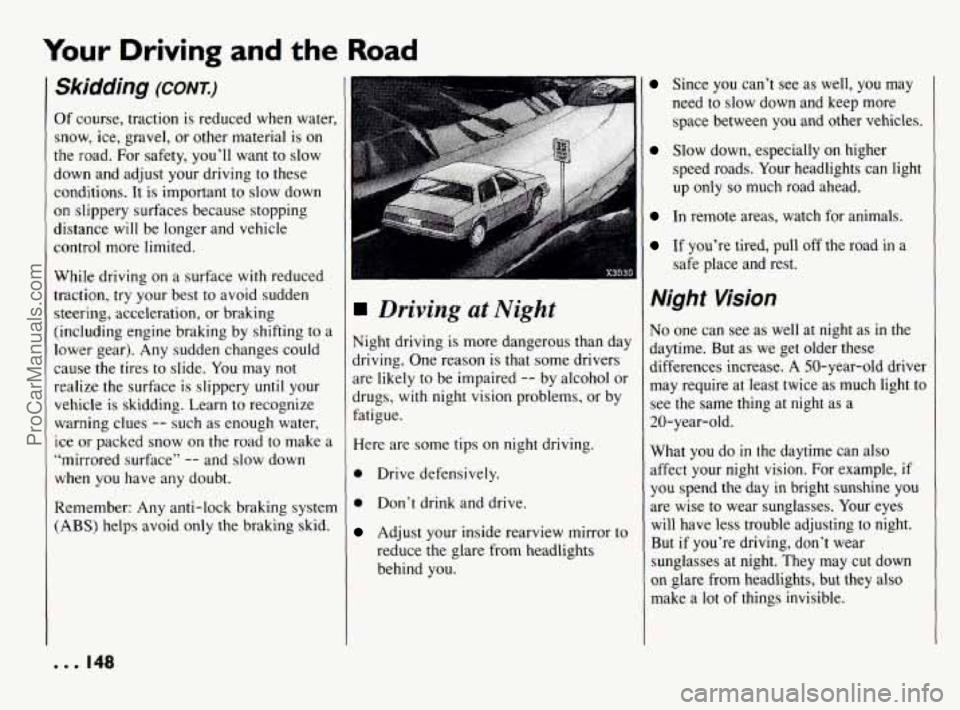
Your Driving and the Road
Skidding (CONI)
Of course, traction is reduced when water,
snow, ice, gravel, or other material is on
the road. For safety, you’ll want to slow
down and adjust your driving to these
conditions. It is important to slow down
on slippery surfaces because stopping
distance
will be longer and vehicle
control more limited.
While driving on a surface with reduced
traction, try your best to avoid sudden
steering, acceleration, or braking
(including engine braking by shifting to a
lower gear). Any sudden changes could
cause the tires
to slide. You may not
realize the surface is slippery until your
vehicle is skidding. Learn to recognize
warning clues
-- such as enough water,
ice
or packed snow on the road to make a
“mirrored surface”
-- and slow down
when
you have any doubt.
Remember: Any anti-lock braking system
(ABS) helps avoid only the braking skid.
Driving at Night
Night driving is more dangerous than day
driving. One reason is that some drivers
are likely to be impaired
-- by alcohol or
drugs, with night
vision problems, or by
fatigue.
Here are some tips on night driving.
0 Drive defensively.
0 Don’t drink and drive.
Adjust your inside rearview mirror to
reduce the glare from headlights
behind you.
Since you can’t see as well, you may
need to slow down and keep more
space between you and other vehicles.
Slow down, especially on higher
speed roads. Your headlights can light
up only so much road ahead.
In remote areas, watch for animals.
If you’re tired, pull off the road in a
safe place and rest.
Night Vision
No one can see as well at night as in the
daytime.
But as we get older these
differences increase.
A 50-year-old driver
may require at least twice as much light to
see the same thing at night as a
20-year-old.
What you do
in the daytime can also
affect your night vision. For example, if
you spend the day
in bright sunshine you
are wise to wear sunglasses. Your eyes
will have less trouble adjusting to night.
But if you’re driving, don’t wear
sunglasses at night. They may cut down
on glare from headlights, but they also
make a lot of things invisible.
. . . 148
ProCarManuals.com
Page 164 of 290
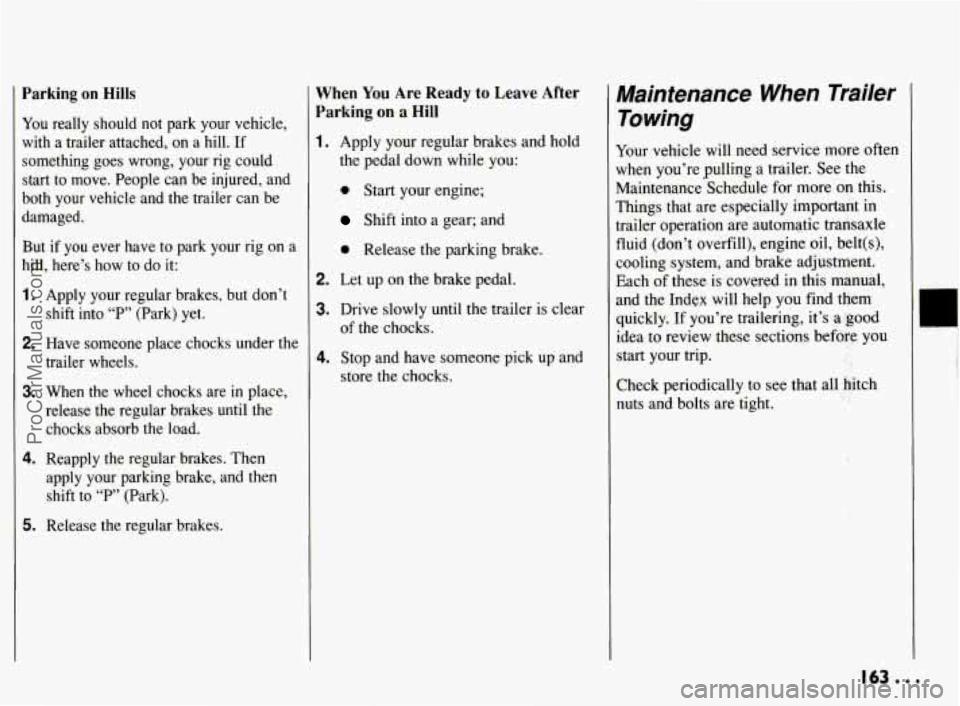
Parking on Hills
You really should not park your vehicle,
with a trailer attached, on a hill.
If
something goes wrong, your rig could
start to move. People can be injured, and
both your vehicle and the trailer can be
damaged.
But if you ever have to park your rig on a
hill, here’s how to do it:
1.
2.
3.
4.
5.
Apply your regular brakes, but don’t
shift into
“P” (Park) yet.
Have someone place chocks under the
trailer wheels.
When the wheel chocks are in place,
release the regular brakes until the chocks absorb the load.
Reapply the regular brakes. Then
apply your parking brake, and then shift to
“F”’ (Park).
Release the regular brakes.
When You Are Ready to Leave After
Parking
on a Hill
1.
2.
3.
4.
Apply your regular brakes and hold
the pedal down while you:
0 Start your engine;
Shift into a gear; and
0 Release the parking brake.
Let up on the brake pedal.
Drive slowly until the trailer is clear
of the chocks.
Stop and have someone pick up and
store the chocks.
Maintenance When Trailer Towing
Your vehicle will need service more often
when you’re pulling a trailer.
See the
Maintenance Schedule for more
on this.
Things that are especially important in
trailer operation are automatic transaxle
fluid (don’t overfill), engine oil, belt(s),
cooling system, and brake adjustment,
Each
of these is covered in this manual,
and the Index will help you find them
quickly. If you’re trailering, it’s a good
idea to review these sections before. you
start your trip.
Check periodically to
see that all hitch
nuts and bolts are tight.
,j.;
i .a
1. i
,
.?.
163...
ProCarManuals.com
Page 280 of 290

Index
Ass Warning Light ............. 98
Accessory Outlet ................ 85
Adding Brake Fluid
................. 218
Electrical Equipment
. . 85. 120. 237
Engine Coolant
.............. 214
Engine Oil
.................. 206
Power Steering Fluid
......... 2 16
Sound Equipment ............ 120
Transaxle Fluid
.............. 2 13
Windshield Washer Fluid
...... 217
Adjustable Support Seat
............ 9
Air Bag ........................ 20
Air Cleaner Filter
........... 209. 243
Air Conditioner
............. 112. 115
Air Conditioner Refrigerant ....... 242
Air Inflator System
.............. 182
Alcohol. Driving Under the
Influence of
.................. 135
Alcohol
in Gasoline ............. 195
Aluminum Wheels
Cleaning
................... 233
Removing
.................. 185
Antenna Fixed
....................... 134
Power
..................... 135
Antifreeze
......... 178. 179. 214. 261
Anti-Lock Brake System (ABS)
... 142
Warning Light
................ 98
Appearance Care and Materials .... 229 Armrest.
Storage
................ 82
Ashtrays & Lighter ........... 83. 84
AM/FM Stereo Radio
......... 12 I
AM/FM Stereo Radios
with Optional Features
....... 122
Cassette Player
.............. 125
Compact Disc Player
......... 126
Gain Control
................ 132
Graphic Equalizer
............ 125
Hearing Damage Warning
..... 119
Radio Reception.
Understanding
....... 133
Radio THEFTLOCK Feature
................... 128
Steering Wheel Controls
....... 13 I
Adding Fluid ................ 2 13
Checking Fluid
.............. 21 1
Audio Systems ................. 1 19
Care of Audio Systems .... 133. 134
“’6. *
Setting the Clock ............. 120
Automatic Transaxle
Shifting
..................... 56
Battery
...................... 220
Jump Starting
............... 167
Battery Warning Light
............ 95
Blizzard
...................... 156
Block Heater. Engine
......... 55. 208
Boost Gage
.................... 102
“Blowout.’. Tire
................ 182 Brake System
Warning Light
Anti-Lock Brake System
....... 98
Standard Brakes .............. 97
Anti-Lock .................. 142
Fluid
.................. 2261 17.
Master Cylinder
............. 217
Parking
..................... 61
Replacement ................ 219
Warning Light
................ 97
Wear Indicators-Front Brakes
.................... 218
Braking
....................... 141
Braking
in Emergencies .......... 144
Braking Technique
.............. 141
“Break-In.
.. New Vehicle .......... 52
Buckling Up (see “Safety Belts”)
Bulb Replacement
Brakes
Headlight
............... 220. 244
Taillight
................ 221. 244
Bulbs. Replacement
............. 244
Capacities and Specifications
.... 242
Carbon Monoxide in
Exhaust
............... 65.66. 157
Card Holder .................... 80
Cassette Tape Player (see “Audio
Center Front Lap Belt (see “Safety Belts”)
Center Passenger Position
......... 25
Systems”)
ProCarManuals.com